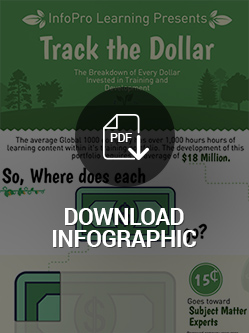A portfolio of training programs represents a significant investment in company resources, including the annual training budgets of years past and the time and effort of training personnel, subject matter experts, and training vendors.
View our Infographic for a visual journey tracking a single dollar invested in a Global 1000 training portfolio
TRAINING IS AN INVESTMENT
Companies have an average training expenditure of about $1,200 per employee per year,1 and over the years, the time and budget spent on curricular design and the creation of learning assets represents a significant investment in company resources. The average Global 1000 company has over 1,000 hours of learning content within its training portfolio. The development of this portfolio requires an average investment of $18 million, including:
- $2.7 million and 18,000 hours of labor from subject matter experts
Subject Matter Experts are a borrowed company resource that are oftentimes highly paid, senior resources that are at the top of their respective divisions within a company. Although they have other job responsibilities and normally consult with the training department, their time is valuable and results in a large organizational investment into training.
- $8.1 million and 100,000 hours of labor from instructional designers
Instructional designers design and develop corporate training programs. Internal IDs have knowledge of your company and its internal workings, and are able to go to business units, elicit training needs, and design programs to address these needs.
- $2.7 million and 67,000 hours of labor from instructors
Trainers are called upon to deliver training programs within companies. They are a payroll investment and a vital part of the training function since they interface directly with employees
- $4.5 million and 34,000 hours of labor from managers
This is a payroll investment into keeping Training, Learning, and Talent Development Managers on staff to oversee your company’s training function. Managers give direction to projects, take responsibility for deliverables, and lead their respective teams of trainers and instructional designers.
- The Association for Talent Development. (2014). “The Association for Talent Development State of the Industry Report 2013.”
What happens to your training investment over time and how can you maximize your return? Answer these questions and more in our ebook “Modernize: A content strategy for maximizing corporate training ROI”.





